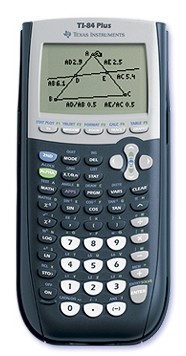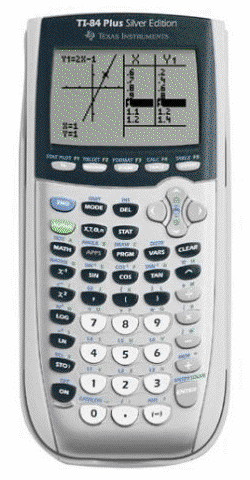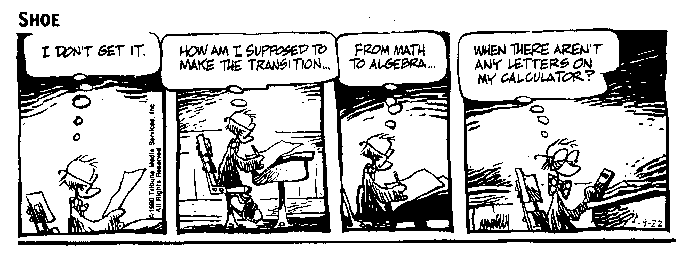
in the
Classroom

 |
Calculators
in the Classroom |
 |

Since the development of small, inexpensive, electronic calculators in the early 1980's mathematicians and teachers of mathematics at all levels have seen the great potential that these instruments have for changing how mathematics is taught, and for changing the way that mathematics is learned. From Principles and Standards for School Mathematics, produced by the National Council of Teachers of Mathematics (N.C.T.M., 2000):
"Technology is essential in teaching and learning mathematics; it influences the mathematics that is taught and enhances students' learning." "In the mathematics classroom envisioned in the Principles and Standards, every student has access to technology to facilitate his or her mathematics learning under the guidance of a skillful teacher."
On the other hand, I believe that the availability of calculators should be limited to students in 7th grade and above, and does not eliminate the need for students to learn algorithms. Proficiency with paper and pencil computational algorithms is important, but such knowledge should grow out of problem situations that have given rise to the need for such algorithms. Students should be able to decide when they need to calculate and whether they require an exact or approximate answer. They should be able to select and use the most appropriate tool. Students should have a balanced approach to calculation, be able to choose appropriate procedures, find answers, and judge the validity of those answers.
I believe that graphics calculators can help students visualize otherwise abstract mathematical concepts. They empower students to take more control of their learning by offering a visual way of discovering mathematical relationships. Appropriate use of graphing calculators also includes use on what I refer to as coincidental computation. Coincidental computation is the arithmetic that occurs during the solving of real problems. That is, when the focus is not on the algorithm, but on the solving of a problem that has been translated from a real situation into an expression that requires evaluation. When the focus is on the algorithm I call the exercise, contrived computation. This is the abstract manipulation of mathematical (algebraic) expressions/equations whose sole purpose is the learning of the computational steps (algorithm) required to simplify or quantify.
I would like to set the minds of my students and their parents to rest on the subject of calculators in the classroom. My students will learn how to do every algebraic manipulation, including graphing, with a pencil and paper because I advocate BASICS FIRST. In addition, every one of the manipulations that it is possible to do on a graphics calculator will be taught on the TI-84+ graphics calculator. Students will be required to know how to use both pencil and paper and graphics calculators for the mathematics taught in my classroom. Students will be led to understand the power of graphics calculators as well as their limitations (as Shoe discovered, above, calculators can't do everything.) Even though calculators will be available most of the time in my classroom (beginning with SAT preparation) there will always be some exercises/problems on test/quizzes that it will be of no help.
I am a firm believer in using technology in the math classroom for all of the following purposes: emphasizing concepts, discovering patterns and relationships, coincidental computation, graphing, developing mathematical intuition, confirming solutions, solving all types of problems (including problems that would not be attempted without the use of graphics calculators) and to encourage higher level thinking skills.
For those who would discourage calculator use for fear the users will become calculator dependent I would give the following example: Suppose you lived on a farm where you often had to dig post holes. Your father, and his father before him, had always used a manual post hole digger. Then you discovered you could dig five times as many holes in the same amount of time using a post hole digging auger on the back of a tractor. I am pretty sure that you could come to prefer to use the auger over the manual post hole digger, but I don't think you would ever lose your ability to use the manual tool. I would agree, however, that you just might become dependent on the auger to give you better post holes in less time, and you may wind up not being able to use the manual digger as well as your father, but I'll wager that you would be willing to give up a little skill with the post hole digger to learn great technique with the auger. And in the end, aren't you really just trying to dig a hole?
It is for all of the above reasons that I recommend that parents of students in my classes purchase TI-84+, or TI-84+ Silver Edition graphics calculators for their children. After the first 6-weeks we will be using the class set of graphics calculators that have generously been provided by the Academys. Often, the work will require that students use a graphics calculator on homework. Students who do not have one at home will have to complete the work at school. Graphics calculators can be purchased at most any office supply store or discount store. This same calculator is used extensively at most high schools, so students can expect to be able to use theirs for many years. Owning a calculator is not required for success in Algebra I, but owning one will go a long way towards facilitating the learning of both Algebra I and graphics calculators.
The bottom line here is that the human instinct to take the path of least resistance, and to use the easiest method available to solve a problem, often encourages overuse of technology. For this reason there will always be problems on algebra tests that cannot be solved/answered using a calculator. There will also be problems that require graphing calculator use on most tests.
As adults in the real world we have lots of "tools" that we use in our everyday lives and in our work that we could do the job without, but that we have become addicted to using to make life/job a little more pleasant with a little less drudgery. The graphing calculator holds the same position in the lives of my students. They can always do the job without the tool, but if the point is to understand the problem and find a solution then the calculator ought to be available to facilitate that end.
I recommend that students not bring their graphics calculators to school as the possibility of damage or loss is too great. There will always be TI-84+'s available in my room for students to use. Students should leave their personal graphics calculators at home for use on homework.
One
final thought. I believe that many people cannot learn to do mathematical
computation at a level that used to be necessary for success in higher-level
mathematics classes. I also believe that no individual should be
excluded from these courses just because they lack fluent computational
skills. Having poor computational skills is not necessarily an indication
that a person lacks the ability to problem-solve at the most difficult
levels. Therefore, if a student lacks manual computational skills,
but he can understand complex real-world problems, define variables, and
write equations that model the situations, I believe he should have access
to the highest levels of mathematics and science classes even if he needs
a calculator to do every computation. No student should be denied
access to higher mathematics simply because he lacks manual computational
skills.